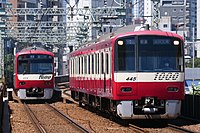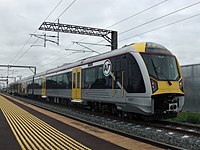This article possibly contains original research. (April 2024) |
This article needs additional citations for verification. (August 2019) |
- A Metra service of double-decker cars hauled by an F40PH in Chicago
- A RER NG train on line E of the Réseau Express Régional in Paris
- A CPTM train on the Coral Line in São Paulo
- A Treno Servizio Regionale train in Milan
- An AM class electric multiple unit used in Auckland
- Two N1000 series EMUs of the Keikyu railway pass each other in Tokyo
Commuter rail or suburban rail is a passenger rail transport service that primarily operates within a metropolitan area, connecting commuters to a central city from adjacent suburbs or commuter towns.[1][2][3] Commuter rail systems can use locomotive-hauled trains or multiple units, using electric or diesel propulsion.[2] Distance charges or zone pricing may be used.
The term can refer to systems with a wide variety of different features and service frequencies, but is often used in contrast to rapid transit or light rail.
Some services share similarities with both commuter rail and high-frequency rapid transit; examples include New Jersey Transit in the U.S., German S-Bahn in some cities, the Réseau Express Régional (RER) in Paris, the S Lines in Milan, many Japanese commuter systems, the East Rail line in Hong Kong, and some Australasian suburban networks, such as Sydney Trains. Many commuter rail systems share tracks with other passenger services and freight.
In North America, commuter rail sometimes refers only to systems that primarily operate during rush hour and offer little to no service for the rest of the day, with regional rail being used to refer to systems that offer all-day service.[4][5][6]
- ^ Transportation Research Board (1989). "Urban Public Transportation Glossary" (PDF). Archived (PDF) from the original on 2019-10-12.
- ^ a b American Public Transit Association (1994). "Glossary of Transit Terminology" (PDF). Archived (PDF) from the original on 2019-10-12.
- ^ "National Transit Database Glossary". 2013-11-13. Archived from the original on 2013-11-13. Retrieved 2019-10-12.
- ^ "What American Commuter Rail Can Learn From Paris". Streetsblog USA. 2017-02-13. Retrieved 2019-10-12.
- ^ Blumgart, Jake (23 April 2021). "Taking the 'Commuter' Out of America's Rail Systems". Governing. e.Republic LLC. Retrieved 11 April 2023.
- ^ Spieler, Christof (24 Aug 2021). Trains, Buses, People, Second Edition: An Opinionated Atlas of US and Canadian Transit. Island Press. p. 54. ISBN 9781642832136.





